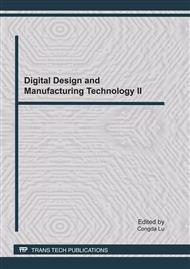[1]
N.R. Chitkara and M. A . Bhuttr: Near net shape forging of spur gear forms: an analysis and some experiments. Int. J. Mech. Sci, Vol. 39 (1996), p.891.
DOI: 10.1016/0020-7403(95)00097-6
Google Scholar
[2]
R.F. Qian: Research on cold extrusion forming for precision gear. Forging & Stamping Technology, Vol. 2 (2005).
Google Scholar
[3]
C.C. Wang: Numerical and experimental study an new cold precision forging technique of spur gears. Transactions of Nonferrous Metals Society of China(English Edition), Vol. 13(2003), pp.798-802.
Google Scholar
[4]
R.F. Qian: Application of cold extrusion technology in precision gear forming. Transactions of the Chinese Society for Agricultural , Vol. 6(2005), pp.131-134.
Google Scholar
[5]
L.L. Ja: Extrusion tools and dies. (Machinery Industry Press, Beijing, 2004).
Google Scholar
[6]
J.X. Xie: Theory and Technology of Metal Extrusion. Metallurgy Industry Press, Beijing, (2001).
Google Scholar
[7]
R.F. Qian and G.J. Hu: Cold extrusion for the Clutch gear process and die design. Die & Mould Industry, Vol. 9(2002), pp.39-41.
Google Scholar
[8]
R.F. Qian and G.J. Hu: Closed forming of cold extrusion in the precision cylindrical gear and mold design. Die and Mould Technology, Vol. 4 (2003), pp.14-16.
Google Scholar
[9]
G.J. Hu and F. Fang: Research and application of metal cold extrusion forming utilising floating die and divided flow. Advanced Materials Research, Vol. 102-104(2010), pp.583-586.
DOI: 10.4028/www.scientific.net/amr.102-104.583
Google Scholar


